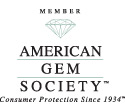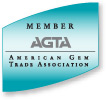Trick or Treat! The Unfolding of the Andesine Scam
October 31st, 2008 by James L. Sweaney, CGA, FGA. GGHumans have always tinkered with natural gem materials and tried to make them better, either by polishing, carving, faceting, coloring, clarifying etc. It’s our nature to try to make things better, to improve on nature, to want more. Some gem treatments are tricks meant to deceive, some are meant to delight.
The actual materials that form a gemstone such as a diamond or ruby are most often naturally occurring rocks, pebbles or mineral crystals. Just like native gold and silver, some of these are beautiful in their own right and can stand on their own merits as an object of beauty—the first “gem enhancement” was probably just a really good washing.
The very earliest jewelers often used natural objects in their original form. Pearls with their mysterious shimmer and luster and beautiful natural form were sought after and treasured from the earliest times. Cleopatra’s fabled emeralds were probably just natural emerald crystals drilled to allow attachment or stringing, given what we know of the technology and style of those times.
Most crystals are not perfect—many are just rounded pebbles with a rough surface, found in the gravel of an old riverbed, that require some fashioning to bring forth their beauty. When humans realized they could create a shiny surface on a pebble by rubbing it with fine sand and powders, and then could look into the stone to see the wondrous colors that sprang forth, the race was on to see who could make the shiniest rock!
Some crystals naturally have flat surfaces, like a perfect diamond octahedron. Men realized that flat surfaces like this could reflect a brilliant flash of light, and so the concept of faceting, putting flat facets on a stone came about.
Over the centuries, many methods have been discovered, often by of trial and error, to improve or brighten the color or sparkle of gems. Somewhen, somewhere, perhaps someone accidentally dropped an imperfect crystal into the dinner stew and when he fished it out, found it more transparent than it had been. Somewhen, someone discovered that boiling a turquoise in sheep fat made the blue color deeper and brighter. Somewhen, someone found that hot balsam sap would penetrate into the cracks in an emerald crystal, and when it cooled, the emerald was both clearer and greener! Somewhen, a miner noticed that gently heating some orange topaz crystals would add a beautiful pink color!
The birth of science and the industrial age added many new avenues and methods for the improvement and creation of gem materials. Our ability to synthesize crystals that were virtually the same as the beautiful natural gem crystals began in the 1880’s when a French scientist named Verneuil developed a method to turn powdered alumina into ruby and sapphire. Carrol Chatham continued the quest creating a “pressure cooker” method for growing emeralds in the lab in the late 1940’s. Truly, this is alchemy, where man works from a plan and turns common materials such as clean sand into synthetic gems including amethyst and citrine.
With our knowledge of the physics of gem materials, we now heat gem materials to very precise temperatures, or bombard them with nuclear energy, or even introduce new elements into an existing crystal structure to produce results that are often striking and beautiful. With this sophisticated knowledge to create has come the power to deceive.
A good example is the recent scam concerning the flood onto the market of red and green feldspar gems. Feldspars are a relatively common gem material, most often seen in such gems as moonstone and labradorite. This beautiful red and green material first appeared about 6 years ago at the Tucson gem show as finished gems in sizes from a carat on up. The dealers claimed the material was from Tibet, and then changed it to Nepal, Mongolia, and Congo – one even intimated to me that the reason for the different origin stories was that it might be clandestinely smuggled out from North Korea. Curiously, there was no legitimate rough material in the marketplace.
This material quickly became the darling and staple of various mass-market websites and television based retailers selling gems. “Andesine”, “Red Labradorite” and “Green Labradorite”, most of it inferior material to begin with, was presented as an ultra rare and desirable gem “investment”. Many thousands of carats were sold this way, often at very high prices. The Chinese government even featured this andesine as the official gem of the Olympics!
For the most part, the traditional jewelry industry backed away from this material, especially as increasing speculation concerning its origins surfaced. None of the dealers would confirm that they had visited the mines. No legitimate pictures of the mine ever surfaced, although one picture purportedly showed an andesine mine in Tibet at an elevation of 19,000 ft. The photo included trees in the background—trees can’t grow at 19,000 ft.—that’s above the timberline.
According to Gem Market News, Sept.Oct 2008, a recent study published by Robert James of the International School of Gemology concludes that the color of this material is artificially induced, the method most likely being diffusion of copper into yellow feldspar. It appears very likely that the vast majority of the material that was sold as andesine during the past few years is not a natural gemstone as represented, but is color treated. This includes the material sold in China as the official stone of the Olympics; at least one TV-based retailer is accepting returns and refunding the purchase price, regardless of date of purchase.
An important part of our mission as professional jewelers and members of the American Gem Society and the American Gem Trade Association is continually update our gem knowledge and to educate our clients about the various treatments and enhancements of gemstones. Consumer protection is a professional responsibility, which we take very seriously—we work to establish long-term relationships with our clients so they can make informed choices about the value and desirability of gems we sell.
In today’s consumer economy, with so many sources and mass outlets for gemstones, it is very easy to be misled or “selectively educated.” The difference when you buy a gem from Mardon is that we are dedicated professionals with over 30 years of experience in this increasingly challenging business. We continually upgrade our knowledge of the gems we sell, we take the time to explain what we sell, and we tell the truth about gems treatments, i.e. full disclosure. No tricks, just treats!








November 2nd, 2008 at 7:34 pm
There’s a interesting blog entry regarding the Andesine scam’s connection to the Olympics at http://edwardbristol.com/2008/08/27/gold-in-carat-scamming-for-andesine/.